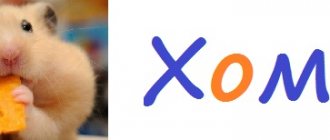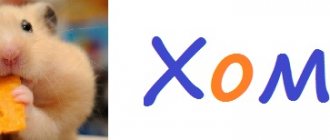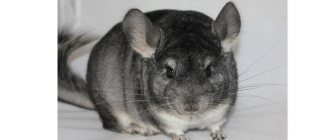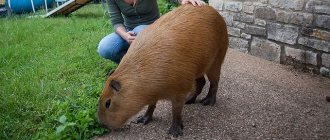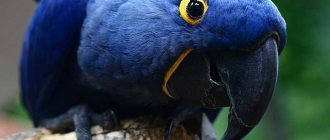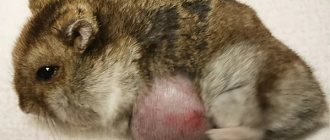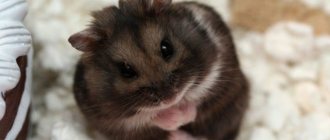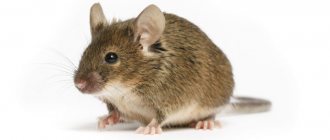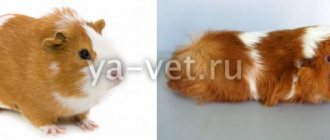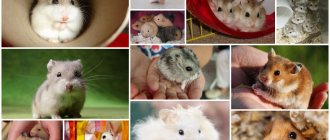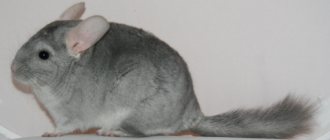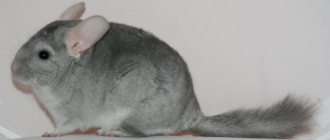The first two species are common in Eurasia, while the blackfoot is found only in North America. Domesticated ferrets are often called ferrets, freds or ferrets from the English ferret. According to the biological classification, ferrets, together with weasels, minks and ermines, belong to the species Mustela of the family Mustelidae (Mustelidae).
Steppe polecat
The largest representative of related species. The length of its body reaches 56 centimeters, the tail is up to 18 cm, and its weight is up to two kilograms. The animal's fur is characterized by a long and thin coat, through which the light underfur is clearly visible. It is distinguished by the darker color of the fur on the paws, the tip of the tail and the presence of a dark mask on the muzzle. It feeds on small rodents, large insects, frogs, and hunts snakes.
Detailed description of the breed: Steppe ferret
Forest polecat
Somewhat smaller than its steppe brother. The body length is up to 46 cm, the tail length is up to 16 cm, the weight of an adult is about 1.5 kg. Color varies from white and red to black. The most common color variant is black-brown, in which the belly, paws and tail are much darker than the rest of the body. Just like the steppe ferret, it feeds on rodents, mainly mouse-like ones, frogs, and hunts birds and snakes.
Detailed description of the breed: Forest ferret
Black-footed ferret
Found only in North America, listed in the Red Book. Almost completely exterminated in Canada and the USA. Now it is bred in captivity and released into its natural habitat. It is distinguished by its small body size and body weight of about 1 kg. The fur is thick, low, darkening towards the tips. The paws, the end of the tail and the mask on the face are almost black. The main food in nature are gophers.
Detailed description of the breed: Black-footed ferret
Classification by color
Thanks to breeding work, the colors of ferrets are extremely diverse. Until 2012, ferrets were classified according to standards developed by the AFA (American Ferret Association). This method is based on the distribution of ferrets according to three main characteristics:
- color;
- color colors;
- distribution of white spots.
Colors:
- Albino.
- Sable.
- Black sable.
- Black.
- Champagne.
- Chocolate.
- Cinnamon.
- White black-eyed (-).
By color colors we mean a pattern on the body of a ferret, formed by the distribution of pigment in the hairline. According to AFA standards, the following colors are distinguished:
- Siamese (siamese),
- Roan (roan),
- Solid
- Standard.
According to AFA standards, it is customary to distinguish the following locations of white spots:
- Blaze (flash, white spots on the head).
- Panda (panda).
- Mitts (mittens).
In addition to the AFA classification, there are standards developed by the Russian Ferret Breeders Association (RFBA) in 2012. The table below contains RFBA ferret colors with photos and names.
The complete absence of pigment in the hair and iris of the eyes is a rare and interesting phenomenon. Despite the obvious difference from their colored counterparts, the albino ferret is no different in either care or maintenance.
| Photo | Name | Description |
| Albino | There is no pigment in the hair and iris of the eyes. | |
Types of ferrets
First, let's figure out what types of ferrets there are, and by what criteria they are distinguished.
Stepnoy
This is the largest and most prolific species. It is found throughout Eurasia, right up to the Far East. The body reaches a length of 55 cm. The tail is 15-18 cm. The steppe ferret weighs 2 kg. Light weight allows the animal to move gracefully and silently. There are up to 18 puppies in a litter.
The wool is colored unevenly. The color is usually dark, ranging from brown to almost black. The underfur is lighter. The belly, paws and tip of the tail are colored darker than the rest of the parts. There are dark spots in the shape of a mask on the face. The guard hairs are short and not particularly thick. It feeds on insects, rodents, snakes, and frogs.
Forest
The distribution area is throughout Western and Eastern Europe, to the foothills of the Urals. It is considered the “progenitor” of domestic breeds. Body length is up to 40-46 cm. The tail is at least 16 cm in length. Weight – 1.5 kg. The female brings up to 6 cubs in a litter. Puppies have a mane that disappears as they grow.
In nature, white and red ferrets are found - the result of interspecific mating of forest and steppe ferrets.
The coat color is brown or black, the underfur is lighter and has a yellow tint. There is a white “mask” on the muzzle. The belly and paws are darker than the main color. Like the steppe ferret, it feeds on mice, gophers, snakes and insects. In addition, forest ferrets hunt for birds.
Read more about this type of ferret here.
American (Blackfoot)
The rarest species. Habitat: North America. Much fewer “Europeans”. Body length – 39-42 cm. Weight – from 0.3 to 1 kg. Rarely found in the wild. The species is on the verge of extinction and is listed in the Red Data Books of North American countries. Zoologists continue to try to restore the population by breeding animals in captivity and releasing them into their natural habitat.
The fur is beautiful, light shades - from cream to yellow. The belly, paws and tip of the tail are darker than the main color, they are almost black. High density of fur and down. The “mask” on the muzzle is black.
Domesticated ferrets
Domesticated forest ferrets are called ferrets. These are large animals, 55-60 cm long and weighing about 2 kg. The word "fretki" is of Polish origin. Also in use are the following names:
- Furo are albino ferrets.
- Honoriki is a hybrid of a mink and a ferret.
- Thorzofrets are a hybrid of wild and domestic ferrets. We don't know what he looks like.
Albino furo ferrets
Hybrid of mink and ferret
Among ferrets, thanks to breeding work, there are many colors. These animals produce offspring from representatives of their group and from wild individuals.
Ferrets have an innate lack of fear of humans, and sleep in their lives takes up to 20 hours a day.
Pastel group
Animals of this group are characterized by very light fur. Unlike albinos, their fur is colored from light beige to light brown. At the same time, the fur is colored unevenly, creating a tinted effect. What stands apart in this group is the cinnamon color, in which the hair has a pronounced orange or reddish tint.
Light pastel (Champagne) Pastel (Pastel) Dark pastel (Chocolate) Cinnamon (Cinnamon)Colors
The variety of ferret colors that can be found is represented by four main categories:
- Siamese, in which the tail and paws are dark, on the muzzle there is a special mask in the form of the English letter “V”.
- Roan. With this color, most of the hair is white. But there may also be gray or pigmented hairs in the coat.
- Solid. With this type, the coat is colored evenly and the color intensity is the same in all parts of the animal’s body.
- Standard. With this color, the proportion of white is about 10%. In general, the color can be of any color, but has different intensities in different places.
Would you like a light ferret or a dark one?
Group of pastel selfies
The group is characterized by the fact that the spine (regardless of its color) is completely colored. Due to this, the frets of the group lack shading. The base color ranges from dark brown in chocolate to snowy white in Dew.
Chocolate self Chocolate solid Champagne self Cinnamon self DewReproduction and offspring
Sexual maturity in ferrets occurs quite early, maximum within 1 year of life. The breeding process of ferrets takes about six months, and the beginning of the process depends on living conditions. Steppe ferrets begin to take care of the birth of future offspring already in March, and forest ferrets - somewhere in mid-spring or even early summer.
These animals do not have signs of a mating ritual, so the mating process takes place vigorously and one might think that the ferrets are fighting. As a result of this process, males can cause minor injuries to females. This is where the role of males in the appearance of future offspring ends, since they do not take any part in raising the future generation.
It is important to know! The female carries her future offspring for one and a half months. From 4 to 20 puppies are born, depending on the number of births the female has. The puppies weigh within 10 grams and are absolutely helpless and blind.
The female feeds her cubs with milk for a maximum of 3 months, but already at the age of one month meat appears in their diet. After about a month, babies' eyes open. After stopping milk feeding, the puppies begin to hunt together with their mother. After six months of life, the offspring begins their own life, independent of their parents.
Markings
Marked (Marked) The top hair has up to 40% dyed and from 60% white. Silver (Silver mitt) Differs from the previous one only in a larger percentage of dyed fur. This type includes exclusively mother-of-pearl group ferrets. Roan (Roan) An even larger amount of colored spine and a smaller amount - white. Panda (Panda) Has a white neck and head with a fairly dark body color. Blaze (Blaze) Characterized by the presence of a continuous and even stripe on the head Mitt Distinguished by the white tips of the paws and tail. Point. In this group of ferrets the contrast between the main color of the fur on the body and limbs is most noticeable. Badger Unlike Blaze ferrets, the white stripe on the head has intermittent or uneven outlines .Milk Mouse (Milk mouth) Characterized by the presence of a pronounced white spot around the nose and eyes Pinto Panda (Pinto panda) Similar to the Panda, but with lighter main fur. Sometimes there are dark “glasses” around the eyes, giving the ferret an even greater resemblance to a real panda. Harlequine Harlequins include domestic ferrets whose colors are difficult to classify, as well as those animals whose color has a pronounced asymmetry.Author: Mayboroda Yuri
Coat types
The color of the coat, nose and eyes is not the only difference between domestic ferrets. These animals can have different types of fur. Working to produce different colors and patterns, breeders developed ferrets with long hair—it stays fluffy without much maintenance.
Wool options:
Angora. The guard hairs reach a length of 7-12 cm. Males have longer hair than females, so they look fluffier. Ferrets with Angora hair have a distinctive feature - their nostrils have an unusual twisted shape.
Half Angora. In semi-angora ferrets, the hair reaches a length of 5 cm, on the belly - 3.5 cm. The phenotype of semi-angora ferrets is assessed based on the results of spring molting, since 3.5 cm corresponds to the length of the coat of normal-coated ferrets in winter.
Normal coat. Hair length in winter is 3.5 cm, in other times – 3 cm. Normal-haired animals have a dense and dense underfur.
Angora ferret
Half Angora
Normal coated ferret
Pet house
Caring for a ferret at home requires arranging a habitat that is as similar to the natural environment as possible. Ferrets are very mobile by nature, so they should be able to move freely around the apartment for at least 5 hours. The animal cannot constantly scurry around the house on its own, because this threatens destruction and injury. You will need a spacious cage.
Domestic ferrets spend a lot of time in their houses, so setting them up is the most important part of their care. The space in the cage should be divided into functional zones:
- place for a feeding trough, drinking bowl;
- place to sleep;
- toilet;
- sleeping area;
- resting-place.
For water, a nipple system is used. If you use a bowl, then only a heavy one that the ferret cannot turn over. The feeder is placed away from the tray. The container for it should also be weighted. The sleeping place is located in the far corner of the cage.
Ferrets love comfort, so an old hat or sweater is suitable as a sleeping place. The ideal option is to install a small wooden house at the end of the cage and fill it with cotton wool or soft cloth. It is recommended to hang several hammocks in the cage: ferrets love them very much. You can use a cat litter box for ferrets, but it is very bulky; it is better to purchase a corner litter box at a pet store.
The cage must have filler on the flooring. Torn newspapers, sawdust or special filler are used as filler. Cell localization is a very important point. It is necessary to choose the quietest corner in the apartment, protected from drafts.
It is also important to equip the cage with all kinds of ladders, shelves and toys.
How to care for animals correctly? Ferrets are quite finicky to care for as pets.
It is very important to monitor your pet’s hygiene, as its health directly depends on it. Care and maintenance include:
- nail trimming;
- ear care;
- water procedures.
Nail trimming
Let's start by trimming the nails. The procedure is carried out once every 21 days. This is done for the safety of the animal. In the wild, the claws grind down on their own, but keeping a ferret at home requires trimming it so that the animal cannot injure itself by getting caught on the carpet or curtains. There are special devices for cutting nails - nail clippers.
Often animals are not happy with this manipulation, so first you need to carry out a distraction maneuver. For example, you can smear something tasty on the animal’s tummy, and while he is licking it, quickly trim his claws
You only need to trim the white dead part, which has no veins or vessels, it is important not to touch the red line
If, nevertheless, you make a mistake and blood splashes, do not panic, but treat the affected area with alcohol and try to calm the animal. It is best to leave him alone in the cage for a while, pouring fresh water into a bowl. If the bleeding does not stop after 10 minutes, you should call a veterinarian.
Bathing and ear cleaning
Keeping a ferret at home requires careful care of the ears. A cotton swab is soaked in special milk or oil. Animals also do not like this procedure, so it is better to carry out manipulations when the animal is sleeping. You should not go too deep, as this may damage your hearing aid. If there is too much dirt, you should check the animal for ear mites.
As pets, ferrets are very playful and love to bathe. Most of the representatives of the species are excellent swimmers and enjoy playing in the bathtub, although there are ferrets who are very afraid of water and bathing is a living hell for them. Such representatives need to be washed in the sink. For those who like to swim in the bathtub, it is necessary to build an island on which the animal will rest.
Ferrets should not be bathed too often, because along with the unpleasant odor, the fat layer is also washed away, without which the animal’s body will be in a state of stress. As mentioned above, ferrets are a type of skunk, therefore, when under stress, they begin to emit a persistent unpleasant odor. To eliminate it, you can purchase a specialized shampoo at a pet store.
After the bath, you need to quickly dry your puppy to prevent him from catching a cold. This will be very difficult to do, because wet animals try to break free and wipe their fur on everything that gets in their way. The ideal option is to catch the animal and place it in a tall box with a towel, thus giving it the opportunity to dry itself.
Interesting Facts
- Frets' sleep can last up to 20 hours,
- If you get a ferret in a rural area, it can kill domestic chickens or regularly destroy their eggs,
- Ferrets were used to photograph Princess Diana's wedding ceremony from a certain angle where photographers could not reach,
- Also, thanks to their unique flexibility, ferrets helped in the construction of Boeing aircraft,
- Like skunks, ferrets can emit an unpleasant musky odor when threatened.
- If necessary, the ferret can dig a hole 5 m deep within an hour.
Important Features
Frets are very active and sociable animals, however, during puberty (5-7 months), as well as during sexual heat, which for males lasts from December to August, and for females from February to July, their behavior changes dramatically. Animals begin to mark their territory, a pungent odor appears from the skin, they often stop using the tray and show aggression towards others.
Females, among other things, do not come out of this state on their own and may die if they are not given the opportunity to mate. The most optimal solution to these problems is castration. Contrary to the popular belief that a castrated animal becomes lazy and inactive, a ferret after castration, on the contrary, spends more time playing, communicating with the owner, and becomes more obedient and careful.
Pay attention to the rules for feeding ferrets. If they are violated, the animal may die
Where does he live?
The habitat extends to the territory of Eurasia and the northwestern part of the African continent. Most often found in Russia, China, England, and Ukraine.
Animals live in small forests and isolated groves. They prefer not to go far into the forest; they like to settle on the edges and clearings. Forest ferrets lead a sedentary lifestyle and are very attached to their chosen place. They occupy a small area and most often use natural shelters as permanent shelters - stacks of firewood, rotten stumps, haystacks, dead wood. They almost never dig their own holes; they can live in offshoots of badger or fox holes.
RAW (English raw - raw)
This feeding scheme is based on the desire to bring ferrets' nutrition as close as possible to their natural diet. Main ingredients:
- rodents (food rats, mice, gerbils, etc.);
- farm poultry (meat, bones, offal).
- As a supplement, they give beef, lamb, quail, quail eggs, feed Madagascar cockroaches and maggots.
If it is not possible to feed rodents, the animal’s diet should be varied as much as possible, paying special attention to feeding chicken meat with sinews, cartilage and bones. All components when feeding RAW should not be subjected to heat treatment, only freezing and washing with water is permissible
Puppies, pregnant and lactating females, molting animals, and sick animals must be given vitamins and minerals in their diet. Vitamin complexes from such manufacturers as have proven themselves well:
- "TOMLYN";
- "Marshall"
- “8 in 1”.
Most often, a two-time feeding scheme is used for adults, while puppies are fed 3-5 times a day. Animals are given enough food because... Ferrets usually eat only the required amount of food and do not overeat. With any of the feeding schemes, it is difficult to resist pampering your pet with a treat, but you need to remember about its nutritional needs and try to comply with them when giving “snacks”.
- You can: quail eggs, banana (a couple of slices), a small amount of cucumber, apple, watermelon, persimmon.
- Not allowed: any nuts, chips, sweets (sweets, cakes, chocolate, etc.), alcoholic, carbonated drinks, dairy products (milk, yoghurt, kefir, fermented baked milk), spicy, smoked and fried, some types of fish.
Be also moderate in treating yourself to grapes or raisins.
Diseases
By nature, ferrets have strong immunity, but, nevertheless, they are susceptible to some diseases.
Among infectious diseases, the greatest danger is plague and rabies, for which there is no cure and the affected animal dies, so kittens should be vaccinated even in childhood.
Non-communicable diseases include the following.
- rickets - most often this problem is faced by young animals that do not receive a balanced diet;
- vitamin deficiency and hypovitaminosis are another problem caused by errors in the animal’s feeding system;
- aplastic anemia - usually manifests itself in females during estrus in the absence of mating;
- gastroenteritis - ferrets encounter this problem if the food contains too much plant food;
- kidney stones are another consequence of an excess of plant components in feed;
- congestive cardiomyopathy is a pathology of the cardiovascular system caused by a lack of taurine in the body;
- stomach ulcer – becomes a consequence of stress and errors in nutrition;
- urocystitis - occurs as a result of hypothermia of the animal;
- cataracts – most often encountered by old or previously injured pets;
- prostate cyst – this disease affects castrated males older than 2 years;
- tumor processes, including oncology.
Animals often suffer from parasite infestation:
- ear mites - transmitted from one sick pet to another, they are not contagious to people;
- fleas - most often the fret is attacked by human lice, as well as cat or dog fleas.
Intensity
Color intensity is determined by the level of color saturation of the ferret's overall appearance relative to other ferrets with a similar color. The intensity depends on the level of brightness of the color and the length of the top part of the coat. The color intensity can change seasonally (in summer the coats are darker and in winter they are lighter) with age. The intensity can also be genetic; in one litter there can be puppies with different intensities of the same color.
- Standard
– intensity accepted as zero value. The value is not written. - Light
/ Light – color intensity is lower than standard. - Dark
/ Dark – color intensity is higher than standard. - White
/ White – zero color intensity (brightness ~ 100%), the color of the ferret is completely white. Due to the complete disappearance of the color that defines the color, this intensity is identified as a separate DEW color. The value is not written. - Black
/ Black - the color of the ferret is completely black. This value is obtained due to an increase in the length of the upper part of the coat and a decrease in the brightness of the lower part of the coat in the black group of colors. The minimum accepted value for the length of the upper black part of Black's coat is 60%. There are three colors in the black group that convey their specific shades: yellow-golden (Gold Black), brown (Sable Black), pure black (Pearl Black).
